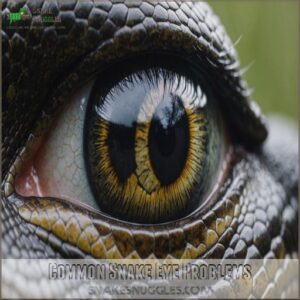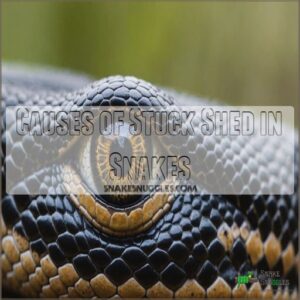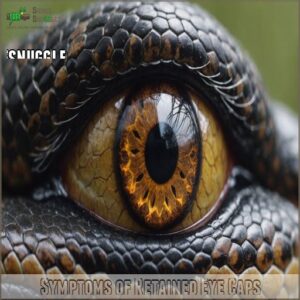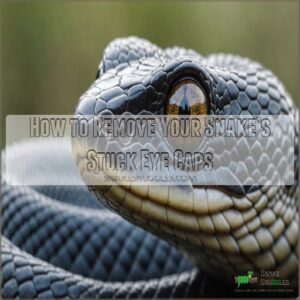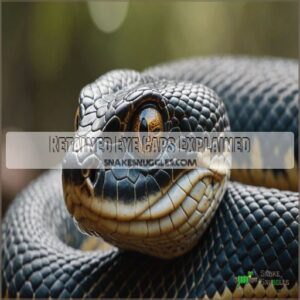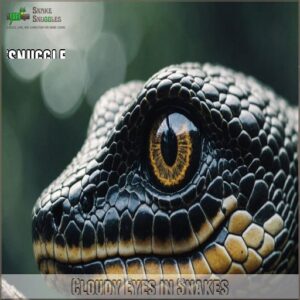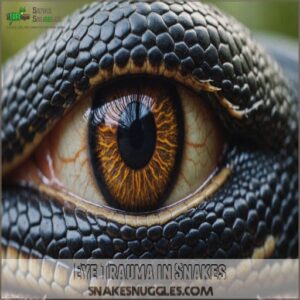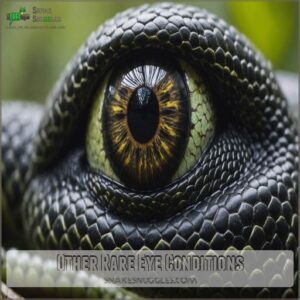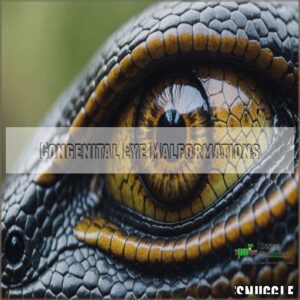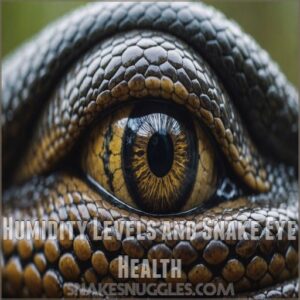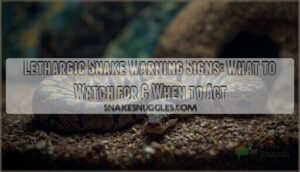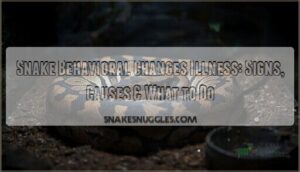This site is supported by our readers. We may earn a commission, at no cost to you, if you purchase through links.

Watch out for symptoms like retained spectacles, cloudy eyes, or signs of trauma.
These issues can be caused by improper humidity, injuries, or pesky mites.
Regularly check your snake’s eyes—think of it as their annual eye check-up, minus the awkward reading chart.
With the right habitat tweaks and prompt attention, you can help your slithery friend avoid these hiccups.
Keep your eyes peeled for more insights on preventing misunderstandings in your snake’s eyesight—trust me, they’ll thank you without blinking an eye.
Table Of Contents
- Key Takeaways
- Common Snake Eye Problems
- What is Dysecdysis in Snakes?
- Retained Eye Caps Explained
- Cloudy Eyes in Snakes
- Eye Trauma in Snakes
- Other Rare Eye Conditions
- Congenital Eye Malformations
- Humidity Levels and Snake Eye Health
- Frequently Asked Questions (FAQs)
- Do snakes hurt their eyes?
- What causes difficulty opening your eyes after sleep?
- Why do snakes have poor eyesight?
- What happens if a snake’s eye gets stuck?
- What is wrong with my snakes eye?
- Do snake eyes ever heal?
- What do infected snake eyes look like?
- What causes snake eyes in humans?
- How can I prevent snake eye infections?
- What signs indicate a snakes vision issues?
- Are certain snake species more eye problem-prone?
- How do temperature changes affect snake eyes?
- Can lighting impact snake eye health?
- Conclusion
Key Takeaways
- Keep an eye on your snake’s symptoms like cloudy eyes or retained spectacles, which can indicate problems needing prompt attention.
- Consistent environmental conditions, such as proper humidity, are vital for preventing issues like retained eye caps and ensuring healthy shedding.
- Address potential causes of eye problems like mites, dehydration, and malnutrition by maintaining a clean habitat and balanced diet.
- Early detection and seeking veterinary advice for persistent cloudiness or trauma can prevent severe complications and promote recovery.
Common Snake Eye Problems
You’ll need to watch your snake’s eyes closely for signs of trouble since they’re protected by special scales called spectacles instead of eyelids.
From recognizing swollen or cloudy eyes as potential signs of infection, which can result from dirty enclosures and poor hygiene, to retained eye caps, these common problems can affect your snake’s health and behavior, but they’re often treatable when caught early.
Causes of Eye Issues
Your snake’s eye problems often start with the basics – just like humans can get cranky without proper care, your scaly friend’s eyes can suffer from dehydration and malnutrition.
Watch out for those tiny troublemakers like mites, which love to irritate your pet’s eyes, and also be aware of fungal infections, such as Snake Fungal Disease (SFD) caused by Ophidiomyces ophiodiicola.
Bacterial infections can sneak in through minor injuries, while improper shedding conditions can lead to retained spectacles, especially when humidity levels aren’t quite right.
Symptoms to Watch Out For
Keeping a watchful eye on snake health means being aware of the general signs of illness in snakes, such as changes in behavior and appetite like lethargy and loss of appetite, spotting trouble before it slithers out of control.
When eye problems strike, they’ll show clear warning signs that shouldn’t be ignored.
Think of these symptoms as your snake’s way of waving a red flag – they’re trying to tell you something’s not quite right.
- Cloudy or hazy eyes that don’t clear up after shedding
- Unusual bulging (exophthalmia) or sunken eyes (enophthalmia)
- Discharge or crusty material around the eyes
- Incomplete shedding with retained eye caps
- Behavior changes like food refusal or increased aggression
Prevention Methods
Now that you can spot the warning signs, let’s get proactive about snake eye care.
Smart husbandry practices make all the difference in preventing eye problems.
Here’s a breakdown of what works:
| Prevention Area | Daily Tasks | Monthly Checks |
|---|---|---|
| Environment | Monitor humidity | Deep clean enclosure |
| Nutrition | Fresh water daily | Evaluate diet plan |
| Health | Check for debris | Schedule vet visits |
These simple steps will help shield your scaly friend from common eye issues while making snake care feel like second nature.
What is Dysecdysis in Snakes?
If you’ve noticed your snake’s eye caps haven’t fallen off during shedding, you’re likely dealing with dysecdysis, a common condition where snakes experience incomplete or difficult shedding.
Your snake’s eye caps should naturally come off with the rest of its skin during a healthy shed, but factors like low humidity or poor nutrition can cause these protective scales to stick, potentially leading to vision problems.
Causes of Stuck Shed in Snakes
Stuck shed, or dysecdysis, often strikes when humidity levels drop too low in a snake’s enclosure.
Think of it as nature’s way of saying something’s not quite right.
Common culprits include improper temperature gradients, inadequate rough surfaces for rubbing, parasites like pesky mites, and stress from handling or environmental changes.
A snake’s shedding frequency is influenced by several factors, including its shedding cycle. Poor diet and dehydration can also throw a wrench in your snake’s natural shedding process.
Symptoms of Retained Eye Caps
Anyone familiar with snakes knows that spotting retained eye caps early can save your pet from discomfort.
You’ll notice empty eye holes in shed skin, cloudy eyes that don’t clear up after shedding, and changes in your snake’s behavior like food refusal or unusual nervousness.
Your normally calm companion might even show signs of aggression.
These symptoms signal it’s time for professional attention.
How to Remove Your Snake’s Stuck Eye Caps
When you’ve spotted those telltale signs of retained eye caps, it’s time to take action.
You’ll need a gentle touch to help your scaly friend.
While professional help is always best, there are some safe methods you can try at home to assist with eye cap removal.
- Create a humidity hide box with damp moss to soften the stuck caps
- Gently soak your snake in warm water for 20-30 minutes
- Use a cotton swab moistened with saline solution to carefully clean around the eye
- Try the tape method: apply and gently remove clear tape over the cap
- Monitor your snake’s behavior and seek vet care if the caps persist
Retained Eye Caps Explained
You’ve noticed your snake’s eyes looking a bit off lately?
It might be dealing with retained eye caps, a common issue where the protective scale covering the eye doesn’t shed properly during molting.
What Are Retained Eye Caps?
Ever wondered why your snake’s eyes look a bit off after shedding?
You might be dealing with retained eye caps.
These are transparent scales that protect your snake’s eyes, acting like built-in goggles.
During a healthy shed, they should come off with the rest of the skin.
But sometimes, they stick around, causing potential health issues.
Retained eye caps, often caused by low humidity or dehydration, can be a sign of snake shedding issues. It’s a common shedding problem that requires your attention for your reptile’s well-being.
Symptoms of Retained Eye Caps in Snakes
Throughout your snake’s shedding cycle, recognize the blue phase where eyes become cloudy or opaque, often a sign that shedding is near, keep a sharp eye out for retained eye caps.
These stubborn scales can cause serious trouble if left unchecked.
If you notice any unusual symptoms, it’s important to address the issue promptly to prevent further complications, such as eye damage, infections, and vision impairment, which can be caused by low humidity and improper environment.
Here are three tell-tale signs to watch for:
- Empty eye holes in shed skin
- Cloudy, dimpled eyes on your snake
- Unusual behavior like food refusal or nervousness
Don’t let your scaly friend suffer in silence.
Spotting these symptoms early can make all the difference in maintaining your snake’s vision and overall health.
Causes of Retained Eye Caps
Your snake’s retained eye caps aren’t just a random hiccup in their shedding process.
They’re often a red flag for underlying issues.
Let’s peel back the layers on what’s causing this eye-catching problem.
Regularly cleaning your snake’s eyes with a reptile eye care product can also help prevent retained eye caps.
| Cause | How It Affects |
|---|---|
| Dehydration | Dries out skin, making shedding difficult |
| Malnutrition | Weakens overall health, including skin |
| Mites | Irritate eyes, disrupt shedding |
| Bacterial Infections | Inflame eye area, complicating shedding |
Temperature fluctuations and congenital ocular malformations can also play a role.
Keep an eye out for these sneaky culprits to help your scaly friend shed smoothly.
Treatment Options
When it comes to treating retained eye caps, you have options.
Let’s explore the solutions that’ll have your scaly friend seeing clearly again:
- Veterinary care: Professional removal and medication
- Home remedies: Warm water soaks and gentle manual removal
- Surgical procedures: For severe cases or complications
- Medication options: Topical ointments to prevent infections
Remember, prevention’s key.
Keep that humidity up and your snake’s diet balanced to avoid future eye cap troubles.
It’s all about giving your reptile buddy the best care possible.
Prognosis for a Snake With Retained Eye Caps
With prompt treatment, the prognosis for snakes with retained eye caps is generally good.
You’ll see improved vision and reduced infection risk after removal.
However, delayed action can lead to long-term effects like scarring or vision loss.
Reptile ophthalmology has advanced, offering better outcomes for conditions like blindness, eye trauma, conjunctivitis, and uveitis.
Remember, early intervention is key.
Just like humans, your scaly friend’s eye health shouldn’t be taken for granted.
Cloudy Eyes in Snakes
You’ve noticed your snake’s eyes looking a bit foggy?
While it’s normal before shedding, persistent cloudiness can signal various issues, from blocked tear ducts to infections.
Early detection and proper treatment are key to prevent vision loss, so let’s explore the causes and solutions for your scaly friend’s cloudy peepers.
Possible Causes of Cloudy Eyes
Cloudy eyes in snakes can stem from various issues, ranging from minor to serious. Let’s explore the potential culprits:
- Blocked tear ducts (nasolacrimal duct blockage) preventing proper drainage
- Infections or keratitis causing inflammation
- Fungal infestations or parasites irritating the eye
Environmental factors like low humidity can exacerbate these problems.
While some cloudiness is normal before shedding, persistent haziness after shedding warrants attention.
Remember, early detection is key to preventing more severe complications, including vision loss.
Treatment Options for Cloudy Eyes
Your snake’s cloudy eyes need attention.
Treatment depends on the cause, so a vet visit is your first step.
They’ll determine if it’s blocked tear ducts, an infection, or something else.
Here’s a quick guide to potential treatments:
| Treatment | What to Expect |
|---|---|
| Eye drops | Daily application, may sting |
| Home remedies | Warm compresses, gentle cleaning |
| Surgery | Last resort, recovery time varies |
Remember, different snake species may require specialized care.
Your vet will tailor the approach to your scaly friend’s needs.
Importance of Early Intervention
Don’t wait to act when you spot cloudy eyes in your pet snake.
Swift action can make all the difference.
Here’s why timely treatment is key:
Regularly checking your snake’s eyes and using products like snake eye drops can help you catch issues early.
- Prevents vision loss: Early intervention can stop issues from worsening.
- Improves prognosis: Quick vet visits often lead to better outcomes.
- Saves money: Treating problems early is usually less costly than dealing with complications.
Remember, you’re the first line of defense in your snake’s health.
Keep a keen eye on those peepers!
Eye Trauma in Snakes
Your snake’s eyes are vulnerable to injury, whether from cage rubbing or prey bites.
Prompt action is essential if you notice any signs of trauma, as untreated eye injuries can lead to serious complications.
Causes of Eye Trauma
While cloudy eyes can be concerning, physical injuries pose an immediate threat to your snake’s vision.
Eye trauma often stems from rough cage decor, overly large prey, or accidental injuries during handling.
Snakes might rub against abrasive surfaces or get poked by branches.
Biting prey can lead to eye damage, and even mites or ticks can cause irritation.
Keep your snake’s environment safe and prey size appropriate to prevent these mishaps.
Symptoms of Eye Trauma
Eye trauma in snakes can be sneaky, but spotting the signs early is key to keeping your scaly friend healthy.
Just like us, snakes show distress when their eyes are hurt.
Here’s what to watch for:
- Redness or swelling around the eye
- Discharge or cloudiness in the eye
- Squinting or keeping the eye closed
- Excessive head rubbing against surfaces
- Changes in behavior, like decreased appetite or increased aggression
These symptoms could indicate anything from a minor scratch to a serious infection.
Keep a close eye on your serpent’s peepers to catch problems before they slither out of control.
Treatment Options for Eye Trauma
Now that you’ve spotted the signs of eye trauma in your scaly friend, let’s talk treatment.
Your vet might prescribe antibiotic treatment to fight infection or suggest surgical repair for severe cases.
Eye lubrication is often key to healing.
At home, you’ll need to keep the enclosure clean and monitor progress.
With proper care, the prognosis is often good.
Remember, swift action can make all the difference in your snake’s recovery.
Other Rare Eye Conditions
While not common, certain rare eye conditions such as cataracts, glaucoma, and conjunctivitis can also affect your snake’s vision and overall health.
Recognizing early signs like irritation or pressure changes can help you seek timely veterinary care, ensuring your reptilian friend stays healthy and happy.
Cataracts in Snakes
Even when eye trauma heals, snakes might still face cataracts that can cloud their vision.
Cataracts in snakes often arise from factors such as poor nutrition or UV exposure.
Consider these four steps:
- Check Snake Nutrition: Important for eye health.
- Limit UV Exposure: Protects against cataracts.
- Regular Vet Visits: Essential for early detection.
- Consider Surgery: Only if suggested by a vet.
Glaucoma in Snakes
Cataracts may cloud your snake’s vision, but glaucoma is the real game-changer.
This rare condition causes increased eye pressure, leading to optic nerve damage, and can steal your snake’s sight.
Early glaucoma diagnosis is key to preserving vision.
Treatment options might be limited, so regular check-ups are your best ally.
Keep your scaly friend seeing the world clearly!
Conjunctivitis in Snakes
After checking for signs of glaucoma, turning your attention to conjunctivitis is wise.
Snakes may show inflamed, reddened eyes—like they’ve been watching too much TV!
Factors like vitamin A deficiency or poor water quality may cause this.
For effective snake eye treatment options, it’s important to identify the root cause.
Here’s what to watch for:
- Puffy, red eyes.
- Frequent eye rubs.
- Excessive tearing.
- Swollen eyelids.
Seek conjunctivitis treatment promptly.
Uveitis in Snakes
Itchy, red eyes make anyone squirm, and snakes are no exception.
Uveitis, inflammation of the middle eye layer, often stems from infections or trauma.
Common signs include swelling, redness, and sensitivity to light.
Eye infections can be caused by bacteria, mites, low humidity, or irritants, making it essential to monitor your snake’s environment and humidity levels, as discussed in understanding snake eye care.
Quick treatment options—medication or vet care—can prevent long-term effects like blindness.
Spot and treat it early to make sure your snake’s eyes remain bright and healthy.
| Sign | What It Means | What To Do |
|---|---|---|
| Redness | Potential infection | Consult a vet |
| Swelling | May indicate trauma | Provide care promptly |
| Light Sensitivity | Inflammation indication | Seek immediate attention |
Mites and Ticks in Snakes
Ever thought those tiny specks on your snake aren’t just dirt?
Mites and ticks love to hitch a ride, causing irritation to their sensitive eyes.
Identifying these pests is essential.
For tick removal, gently use tweezers.
Consider treatments like reptile-safe sprays.
Prevention strategies include regular cleaning.
Neglect can lead to long-term effects, impacting your snake’s health.
Congenital Eye Malformations
Sometimes, snakes are born with eye problems. These congenital malformations, like anophthalmia (missing eyes) or microphthalmia (small eyes), are rare but can be devastating, often linked to issues during incubation.
Anophthalmia in Snakes
Your snake’s unique charm might include anophthalmia, where it’s born without eyes. It sounds like a reptilian mystery, but understanding this condition isn’t rocket science. Here’s the scoop:
- Anophthalmia diagnosis helps breeders plan.
- Breeding implications can impact genetic lines.
- Survival rates vary but are generally low.
- Alternative senses often enhance their quality of life.
Microphthalmia in Snakes
Anomalies in snake development can appear as microphthalmia, where genetics may shrink their eyes.
With the prognosis often connected to breeding choices, understanding treatment options is essential.
Though small, these snakes can still lead healthy lives with proper care.
Remember, careful breeding reduces genetic risks.
| Aspect | Details |
|---|---|
| Cause | Genetic |
| Affected Areas | Eyes |
| Impact on Life | Manageable with treatment |
Cyclopia in Snakes
While microphthalmia involves unusually small eyes, cyclopia is even more alarming—two eyes forming in a single socket.
This rare congenital malformation often suggests deeper genetic issues.
Unfortunately, the prognosis is grim, as cyclopia usually comes with severe brain deformities.
Despite the rarity, understanding such causes can offer insight into your snake’s health needs, though treatment options remain limited.
Prevention Through Proper Incubation
Imagine this: you’re cradling your snake’s future in your hands.
Ensuring proper incubation temperature and maintaining egg humidity can prevent congenital eye malformations.
Give those eggs the TLC they need by monitoring incubation time and practicing careful egg handling.
A clean incubator isn’t just a nice-to-have; it’s essential for preventing serious deformities.
Your careful steps today safeguard tomorrow’s healthy hatchlings.
Humidity Levels and Snake Eye Health
Maintaining the right humidity levels in your snake’s enclosure isn’t just about comfort—it’s essential for their eye health too.
Without proper humidity, your scaly friend might face shedding issues, leading to retained eye caps that could impair vision and cause infections.
Ideal Humidity Levels for Different Species
You’ve probably wondered about the impact of humidity on your snake’s health.
Ensuring the right moisture levels in their enclosures can prevent issues like retained eye caps.
Here’s a quick guide for different species:
- Corn snakes thrive with 40-60% humidity.
- Ball pythons need 55-60%.
- Green tree pythons require 80-90%.
Importance of Humidity for Shedding
Knowing the right humidity is key for healthy shedding.
Too little moisture, and you’ll face stuck sheds, including those pesky retained eye caps.
See how humidity impacts your snake’s health:
| Humidity (%) | Shedding Problems | Snake Health |
|---|---|---|
| 60% | Rare shedding problems | Healthy, hydrated |
Proper humidity prevents these issues, keeping your snake happy and healthy.
How to Maintain Proper Humidity Levels
Maintaining proper humidity levels is important for snake health, affecting eye issues and shedding ease.
So, how do you do it?
To achieve the right humidity, it’s key to research the specific humidity needs of your snake species, such as snake species humidity requirements.
- Misting frequency: Mist regularly based on your snake’s species requirements.
- Substrate choices: Choose substrates like coconut fiber, aiding moisture retention.
- Enclosure ventilation: Make sure there’s adequate airflow while keeping humidity at the right level.
Your snake will thrive with these simple steps!
Frequently Asked Questions (FAQs)
Do snakes hurt their eyes?
Like a clumsy dancer bumping into furniture, snakes can occasionally injure their eyes through rubbing against their enclosures or during prey encounters.
Minor injuries often heal naturally, but serious cases might need veterinary care for infection prevention.
What causes difficulty opening your eyes after sleep?
Waking up with difficulty opening your eyes often results from dry, sticky mucus produced overnight.
This occurs due to reduced blinking and tear production while you sleep.
Gently rinsing your eyes with warm water usually helps.
Why do snakes have poor eyesight?
You’d think vision would be important when hunting dinner, but snakes rely more on scent and heat detection.
Their poor eyesight stems from evolution, trading sharp vision for enhanced smell and thermal sensors to track prey.
What happens if a snake’s eye gets stuck?
If your snake’s eye cap gets stuck, it’s called dysecdysis.
Increase humidity; soak it in warm water.
Gentle removal might be needed, but a vet visit’s best for tricky cases.
Prevention’s key – maintain proper humidity!
What is wrong with my snakes eye?
Imagine peering into your snake’s eye, noticing clouds instead of clarity.
This could indicate retained eye caps, dehydration, or infection.
Consult a vet for a definitive diagnosis, ensuring a swift path to recovery for your slithering friend.
Do snake eyes ever heal?
Snake eyes can heal from common issues like minor injuries or cloudiness due to shedding, but serious conditions require veterinary care.
Snake eye health and recovery can be supported by providing proper humidity, diet, and cleanliness.
What do infected snake eyes look like?
Infected snake eyes often appear red and swollen, with possible discharge or unusual cloudiness.
You might notice the snake rubbing its eyes against surfaces.
Left untreated, infections can lead to serious complications like vision loss.
What causes snake eyes in humans?
A classic case of "snake eyes" in humans refers to a unique, striking eye makeup technique.
Artistically, it features bold, elongated black liner mimicking snakes’ pupils.
This technique brings an edgy twist to the fashion world, creating dramatic looks.
How can I prevent snake eye infections?
Maintain your snake’s health by ensuring proper humidity levels, feeding a balanced diet, and keeping their enclosure clean.
Regular misting and providing ample fresh water also help prevent infections, keeping your snake’s vision clear and bright. Snakes’ eye health is also maintained by their natural ability to produce lacrimal fluid, which lubricates and moisturizes their eyes, ensuring clear vision.
What signs indicate a snakes vision issues?
Imagine driving with fogged-up glasses—yep, it’s that annoying!
Your snake might squint, appear nervous, or avoid food.
Look for cloudy eyes or empty eye holes in shed skin as tell-tale signs of vision trouble.
Are certain snake species more eye problem-prone?
While all snakes can get eye problems, some are more susceptible.
Species with specific needs, like high humidity, are more prone to issues if those needs aren’t met.
Proper care prevents most eye problems.
How do temperature changes affect snake eyes?
Snake eyes, sensitive yet resilient, can suffer from temperature swings.
Cold slows metabolism, leading to cloudy eyes, while excessive heat dries the spectacle scales.
Maintain stable temperatures to keep your slithering friend’s eyes clear and healthy.
Can lighting impact snake eye health?
Lighting plays a very important role in maintaining a snake’s eye health.
Inadequate lighting can stress snakes, affecting their overall well-being and eye condition.
Provide proper UV lighting to support normal behavior, shedding, and vitamin D synthesis.
Conclusion
It’s ironic that snakes, with their unblinking gaze, can have so many eye issues.
Spotting the snake eye problems early can prevent bigger headaches—or heartaches—down the line.
Regular checks for retained eye caps, cloudiness, or trauma can make all the difference.
Don’t overlook the importance of maintaining proper humidity and identifying mites quickly.
Your vigilance helps your slithery friend slither smoothly, seeing the world with its renewed, clear-eyed curiosity.
Your snake may not blink, but you’ll rest easy.

